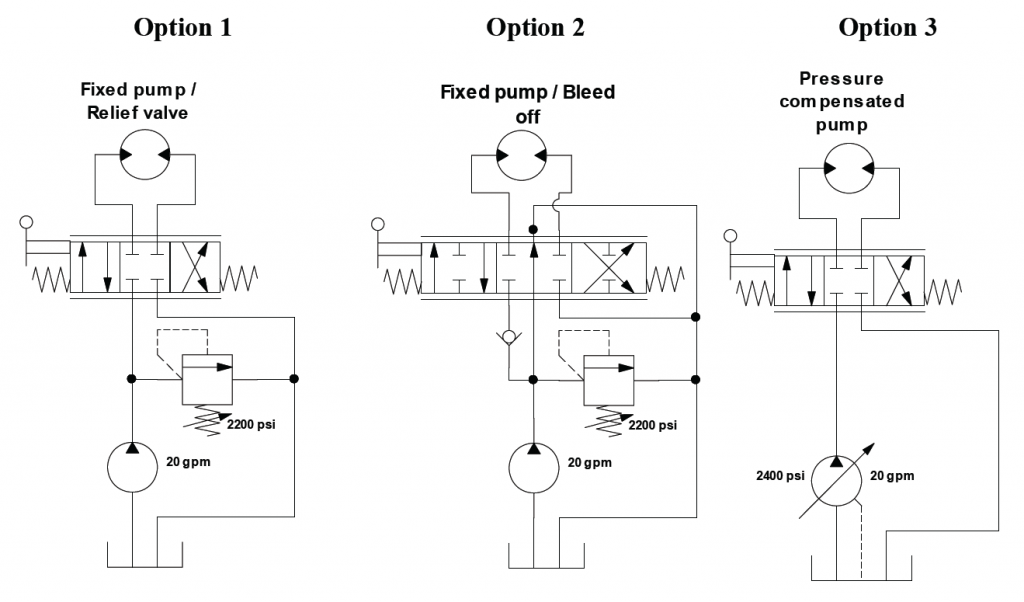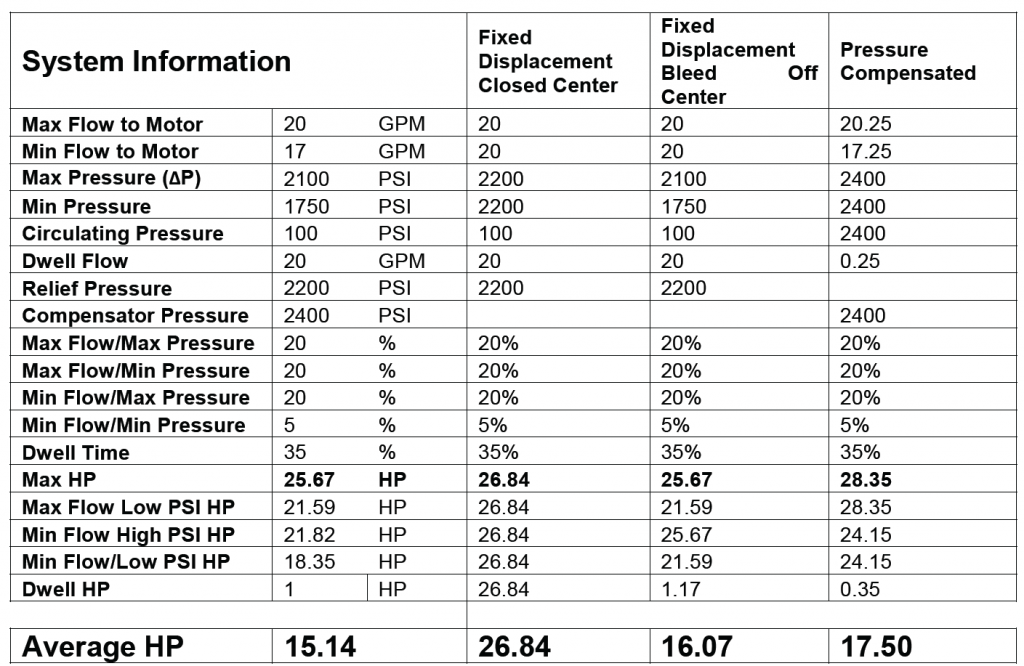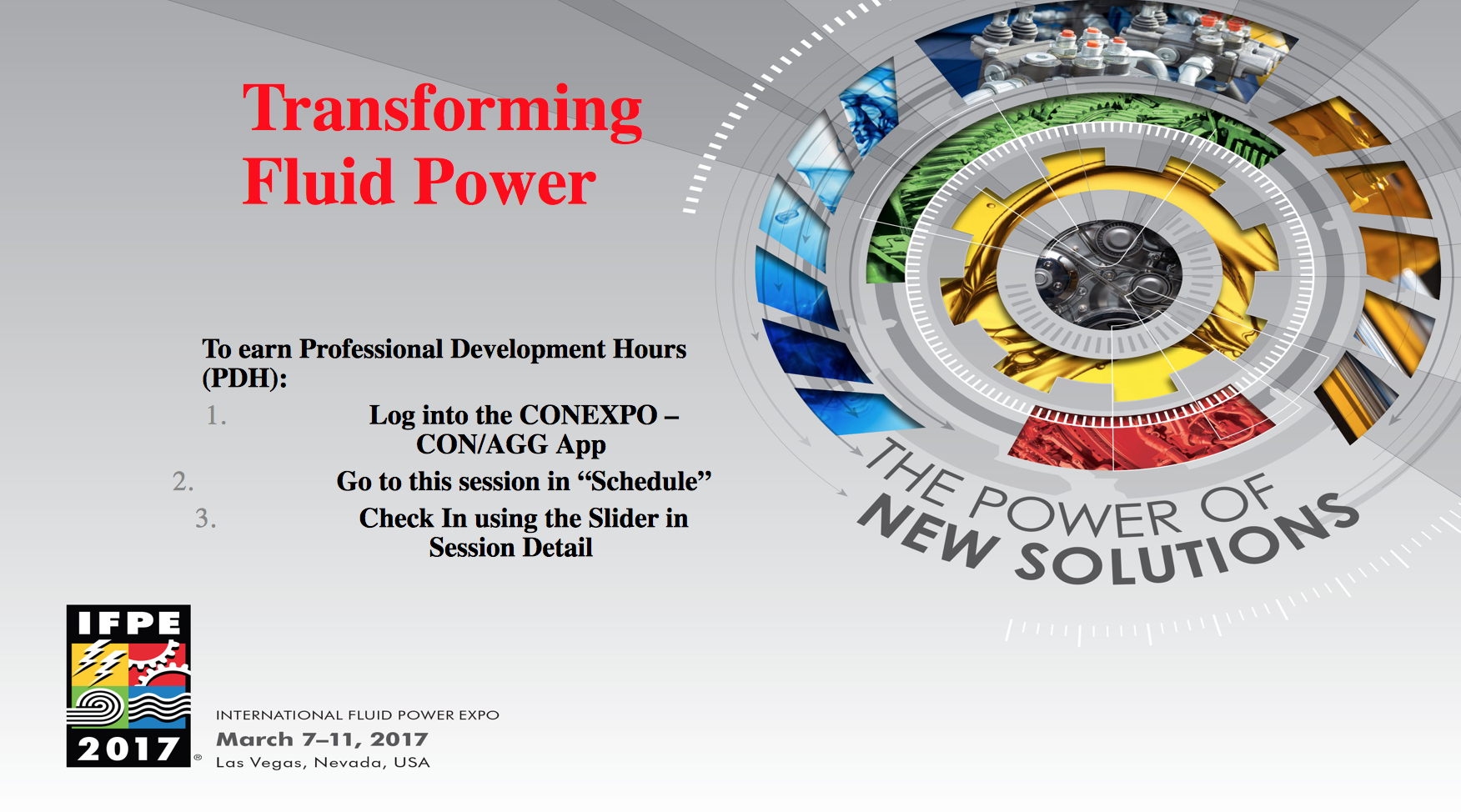Efficient Hydraulic Systems
I think I may have a surprise for you.
We will look at a system and try three different hydraulic systems and see which is best from an energy perspective. The requirements are these: a hydraulic pump needs to supply either 17 or 20 gpm at either 1,750 or 2,100 psi to do some work. 20% of the time the system operates at maximum flow and maximum pressure. 20% of the time it is at maximum flow and minimum pressure. Another 20% of the time it sees minimum flow at maximum pressure. 5% of the time it is at minimum flow and minimum pressure. That leaves 35% of the time during which the system is idle (dwells).
We will first use a fixed displacement pump, a relief valve, and a metering directional control valve that has a center condition with all ports blocked. We will then try a fixed displacement pump, a relief valve, and a metering directional control valve with a center condition where all pump flow goes to tank (a bleed off circuit). Finally, we will try a pressure-compensated pump and a metering directional control valve with a center condition having all ports blocked. (See circuits below.)
Let’s see a show of hands. How many of you think the first application will be the most efficient? I see three hands. Okay, how many think the second option will be most efficient? I see twelve hands. How many think the third option will be the best? Wow! Number three is the big favorite.
Now, let’s do the math. For those of you who are not yet Fluid Power Professionals, we will be using the formula HP = (GPM × psi) / 1714.
In the first instance, we will have a pump that produces 20 gpm with the relief valve set at 2,200 psi. This pressure is for 2,100 psi to do the work, 100-psi tank line pressure, and 100-psi buffer.
In the second instance, we will use the same 20-gpm pump and relief set at 2,200 psi.
In the third system we will use a pressure-compensated pump set at 2,400 psi. This pressure is higher than the relief settings on the fixed displacement pumps because this pump begins to compensate at about 90% of the compensator setting, so we need the higher pressure to be certain we have enough flow to do the job.
The chart below is taken from a working spreadsheet. You can find it on line at:
http://www.cfpsos.com/Most%20Efficient%20Hydraulic%20System.xls.
Only three of you will be surprised to see that the fixed pump with a closed center valve is not the most efficient. Twelve of you either knew or played a hunch. The rest of us are probably a little surprised that the bleed-off circuit beat out the pressure-compensated pump by about 0.5 hp.
We will take a look at what is happening. It is important to understand the “why” as well as the “what” when we are specifying components.
The pressure-compensated pump and the fixed closed center system have something in common. They are always at maximum pressure at the pump. The difference is the flow. The fixed pump produces 20 gpm continually. Any flow that is not needed for the job is sent across the relief valve at full pressure. So this system always operates at maximum hp no matter what.
The pressure-compensated pump always operates at its set pressure, but it will vary the flow based on demand. But when the required pressure is less than the compensator setting, there is a pressure drop across the metering directional control valve. The excess energy goes into heat. In addition, there is a constant case drain flow of about 0.25 gpm, which is also generated at compensator pressure. So, even when in dwell mode, the system remains at compensated pressure.
The bleed-off system and the fixed closed center system also share a characteristic. They both produce all the flow all the time. The big difference, listen up now, the big difference is that the fixed closed center system is always at relief pressure. The bleed-off system is always at load pressure. Any excess flow from the bleed-off circuit is diverted to tank at load pressure, not at relief pressure. In a dwell mode, all flow is directed to tank at a low pressure.
I am not saying that the bleed-off system is always the best. I am trying to point out that we need to do our homework and look at all the options when offering the best in fluid power.
Forget the fudge factor, reject the rule of thumb, shun the shortcut, do the math.







Now if your prime mover is a VFD Drive and you use the fixed displacement bleed off centre system, you will reduce your standby horsepower even more. And to be honest, anyone using a fixed displacement pump and a closed centre valve for an actual real world application where the prime mover is always turning should not be designing hydraulic systems and shouldn’t be used as an example for your initial question.
Will,
Thanks for commenting. The intent of the article was not to show the most efficient system possible, but to help us think and not assume that pressure compensation, load sensing, or accumulators are automatically going to produce the most efficient systems. Many of us are stuck in a single mode of operation (including the use of VFDs) and need to be nudged to make sure we do the math.